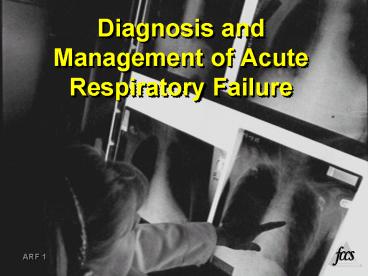Diagnosis and Management of Acute Respiratory Failure - PowerPoint PPT Presentation
1 / 31
Title:
Diagnosis and Management of Acute Respiratory Failure
Description:
Describe pathophysiology of acute respiratory failure. Discuss diagnostic and ... Respiratory failure is common. 360,000 cases per year ... embolus. High ... – PowerPoint PPT presentation
Number of Views:413
Avg rating:3.0/5.0
Title: Diagnosis and Management of Acute Respiratory Failure
1
Diagnosis and Management of Acute Respiratory
Failure
ARF 1
2
Objectives
- Describe pathophysiology of acute respiratory
failure - Discuss diagnostic and treatment strategies
ARF 2
3
Respiratory failure is common
- 360,000 cases per year in the United States
- 36 die during hospitalization
- Morbidity and mortality rates increase with age
and presence of comorbidities
4
Acute Respiratory Failure
- Hypoxemic (oxygenation)
- Room air PaO2 ? 50 mmhg
- Hypercapnic (ventilation)
- PaCO2 ? 45 mmhg
- Work of breathing
5
(No Transcript)
6
Indication for intubation(not necessarily
respiratory failure)
- Hypoxemia
- Hypercarbia
- Work of breathing
- Cant protect airway
- Heavy secretions
- Need procedure
- Getting toxic!!
7
Pathophysiology of Hypoxemia
- Ventilation/perfusion mismatch (B, C)
- Shunt physiology (A)
- Alveolar hypoventilation (nl A-a gradient)
- Decreased diffusion of O2
- High altitude (low PiO2)
8
Hypoxemia
SHUNT
O2
Hypercarbia
V/Q
9
Pathophysiology of Hypoxemia
- Ventilation/perfusion mismatch (B, C)
- Shunt physiology (A)
- Alveolar hypoventilation (nl A-a gradient)
- Decreased diffusion of O2
- High altitude (low PiO2)
10
PAO2-PaO2 gradient
- PAO2 FiO2 (Patm - pH2O) - (1.25 x PaCO2)
- Simplistically in Denver on room air
- PAO2120- (PCO2 x 1.25)
- PaO2- from blood gas
- PAO2-PaO2 age/4
11
ClearRadiographic Patterns of Hypoxemia
- Poor response to FiO2
- Shunts
- Intracardiac shunt
- Intrapulmonary shunt
- AV malformation
- Desaturated mixed venous blood- (shock)
- Good response to FiO2
- Airway obstruction
- Obesity/upper airway closure
- Asthma/obstructive lung disease
- Pulmonary embolism
- Hypoventilation
12
Hypoxemia
SHUNT
O2
Hypercarbia
V/Q
13
Diffuse or focal? Radiographic Patterns of
Hypoxemia (Blood, Pus or Water)
- Hydrostatic edema
- JVP, cardiac HX, S3, S4
- Bronchopneumonia
- Fever, WBC, sputum
- Aspiration
- History, mental status
- ARDS
- Precipitating cause?
14
Hypercapnia
- PaCO2 VCO2 / VA
- VA RR x (Vt-Vd)
- RR, Vt, Vd
- which parameters are creating hypercarbia-Why??
15
Pathophysiology of Hypercapnia
- Decreased tidal volume (Vt) and/or respiratory
rate (RR) ?Ve - Cant breathe
- Airways
- Parenchyma
- Pleura, chest wall, abdomen
- Muscles weak
- Wont Breathe (Drugs, OHS, CNS)
16
(No Transcript)
17
Increased Dead Space
- Hypovolemia
- Low cardiac output
- Pulmonary embolus
- High airway pressures
- Compensate by increasing tidal volume and/or
respiratory rate - If unable to compensate? resp failure
18
Manifestations of Respiratory Distress
- Altered mental status
- Increased work of breathing
- Tachypnea
- Accessory muscle use, retractions, paradoxical
breathing pattern - Catecholamine release
- Tachycardia, diaphoresis, hypertension
- Abnormal arterial blood gas values
ARF 18
19
Principles of management
- Identify problem
- oxygen? ventilation? Work of breathing?
- Supplemental oxygen?
- Assist in ventilation?
- Reduce work of breathing?
- Identify etiology
- Assess reversibility
20
Acute Respiratory Failure Management
- Oxygen supplementation
- Increase FIO2
- Match flow between delivery device and
inspiratory demand
ARF 20
21
Nasal Cannula
- 100 oxygen delivered
- Low flow
- lt0.55.0 L/min
- Low oxygen
- FIO2 lt0.40.5
22
Reservoir Face Mask
- Reservoir bag filled with 100 O2
- High oxygen
- High flow
23
Resuscitation Bag-Mask-Valve Device
- 100 O2
- High flow (gt 15 L/min)
- Emergency equipment
- Little to no air entrainment with firm fit
24
Pharmacologic Adjuncts
- Bronchodilators
- ?2-agonists
- Anticholinergics
- Corticosteroids
- Lasix/Vasodilators
- Antibiotics
- Anticoagulation or thrombolysis
25
An approach
- ? Hypoxemia and/or hypoventilation
- Need ABG, Use SPO2
- ? A-a gradient
- ? Response to 100 FiO2
- ? CXR clear or white
- ? Work of Breathing
- ? Etiology? treatment
26
7.32/50/48 (SPO2-83)
27
7.45/33/52 SPO2-87
28
7.28/60/45 on RA (SPO2-80)
29
7.48/30/56 (SPO2-89)
30
7.48/30/46 (SPO2-83)
31
THE END































